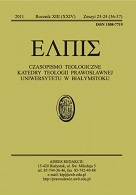Sakralna muzyka bizantyjska i jej wpływ na staroruską muzykę cerkiewną
Sacred byzantine music and its influence on old East Slavic Orthodox music
Author(s): Włodzimierz WołosiukSubject(s): Christian Theology and Religion
Published by: Wydawnictwo Uniwersytetu w Białymstoku
Keywords: liturgy; music; chant; Orthodox Church music
Summary/Abstract: Sacred Byzantine music originates from three sources: “the liturgy of heaven”, synagogue music as well as old Greek theory of music and lays at the bottom of the East Slavs liturgical chant. The tonal base of the Byzantine music formed tetrachords. From them the so called Diatonic mode took shape. It was the easiest and the most popular sound arrangement steming from Greek music. The Cristian Church considered it to be in accordance with its Spirit and needs. From the tetrachords mentioned above other tones were created, namely Doric tones, Lydian, Phrygian and Mixolydian and, together withall their derivatives they gave beginning to the Oktoechos tradition. Byzantine music was flourishing in monasteries and in town areas andmany different forms were elaborated on like troparions, kontakions, stichiry, canons, etc. If one speaks about composers then certainly some names cannot be omitted. These are: St. Anatolius (Patriarchof Constantinople), St. Andrew of Crete, St. Romanos the Melodist,St. Sophronius of Jerusalem and, above all, St. John of Damascus who collected and systematized the liturgical chants creating mentioned Oktoechos. The acceptance of the Greek form of Christianity by Rus’ caused a cultivation of the sacred Greek vocal art on its territory which manifested in a form of so called Znamenny chant. This type of chant was at first similar to the Greek model but later on it moved away from it. Musical notation of the Old East Slavic singing was based on neumes which names in Old East Slavic have changed a little and only few survived. Furthermore, liturgical note books together with their genre and music content have been taken over from Byzantium. Especially visible in the Old East Slavic monody, Byzantine patterns were pervading also the later polyphony which proves they were always current. Moreover, this allows to claim that Rus’ became the real successor of the Greek Orthodox traditions in new circumstances of sacral musical culture in the whole Eastern Europe.
Journal: Elpis
- Issue Year: 2011
- Issue No: 13
- Page Range: 59-86
- Page Count: 28
- Language: Polish

